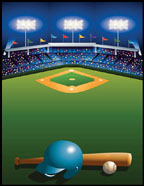
Technical Supplements
Click on these items, or Scroll Down, to see details on what each Technical Supplements covers.
1A - - Bat-Ball Collision Basics / Impact of your Body Parts
2A - - Bat Speed Introduction / Circle I and Circle II
3A - - Competing Forces (Centrifugal Forces)
4A - - Extension (The Mechanics)
5A - - The TAW Effect (The Mechanics)
6A - - Bat Speed vs. Bat Weight
7A - - Energy: The Analytical Portfolio

Ordering Info for Supplements
These supplements are not intended for your everyday coach or player. They provide a much more Analytical Perspective on the swing for Sports Scientists, Weight Trainers, Physical Therapists, and for those who like graphs and tables.
Please email us at: info@gettingallofit.com

Supplement 3A:
Competing Forces (Centrifugal Forces)
This supplement covers the centrifugal forces that you have to compete with at the plate.
Quantitative numbers are given for the obvious ones that pull the bat out of your hands.
It also reveals the reduction in power if, during “knob to baseball”, the bat-head is 5 inches further out from your body.
Most enlightening is the “High Fastballs” discussion, where you that you cannot change your aim once the bat reaches a certain speed. This is critical for batters to understand. It’s also good information for pitchers as to “why high fastballs are such an effective strikeout tool”.

Supplement 4A:
Extension - The Mechanics
This supplement explains the mechanics (descriptive physics) of the Middle of your Swing, yet in more detail than inThe Science of the Swing.
It covers the Centrifugal Effect (the bat flinging out) and Extension. Clarifies the "push" of Extension vs. the “Push/Pull" you do at the same time.
Compares the baseball swing to the Golf Swing.
Supplement 5A:
The TAW Effect
Explains the mechanics (descriptive physics) of the TAW Effect (the last 1/3 of your swing), using a couple of different analogies, so that you can better understand what you see in videos.
Discusses how the Front Leg Snap provides the actual power for the TAW Effect, and how to extend the hitting zone - - as well as kill it.
Finally it discusses the Finish to your swing.
Supplement 6A:
Bat Weight vs. Bat Speed
Displays the power your get from increasing the bat-weight versus increasing the bat’s speed.
Explains why professional bats have settled down into a surprisingly narrow range of 31-35 oz bat-weight.
Supplement 7A:
Energy: The Analytical Portfolio
This supplement is the analytical section, full of graphs and tables displaying your power (bat's energy).
Displays the components of your bat speed, over time, for a typical Minor League swing.
Explains the problem of using bat speed (use bat energy instead) to represent your power.
Supplies the bottom-line graph showing the 5 sources of your power and their % contribution. These are the Rear foot Push-off, the Centrifugal Effect, Extension, the “Push/Pull”, and the TAW Effect.
As Extension occurs, it compares (graphs) the increasing energy of the bat (your power) to that wasted on increasing the energy of your arms (Ice Skater losses).
For the final TAW Effect, it graphs the resulting bat energy for various pulling forces of your Lead Arm.
Supplement 8A:
Portfolio of Forces
This supplement is full of graphs and tables showing how the many forces vary over time.
A fascinating graph shows the torque on the bat resulting from the Centrifugal Effect, and
Another shows how the centrifugal force on the bat is split between rotating it (creating that torque) versus pulling it out of your hands (encouraging the TAW Effect).
Extension forces, of both the "push" and the “Push/Pull”, are plotted over time for each arm.
Those “Push/Pull” forces (torque) are compared to the above torque aspects of the Centrifugal Effect.
Discussions reveal how you get a reasonable TAW Effect, during Extension and prior to the Front Leg Snap, by the pulling action during Extension.
Finally, it discusses your Lead Arm handicap, i.e., why you have to pull with much more than, say, 100 lb of force, to get a net 100 lb of “TAW Force”.

Supplement 9A:
At-the-Plate Choices
Graphs are supplied for both Choking Up (2 in) and Hugging the Plate (2 in), comparing the bat’s energy over time to that of the Standard Swing. This is during extension.
Graphs then compare the subsequent TAW Effects (for different pulling strengths) for the same two scenarios.
Conclusions are made regarding pull-hitting and choking up.
The Barry Bonds swing is analyzed.
Supplement 10A:
Weight Room Choices
First is a general discussion of weight room choices and managing the ratio of arm vs. torso vs. leg muscles.
Adding Muscle: We evaluate the impact of seeking 2.5% more torso speed, and how that impacts your power.
Adding Fat: We then evaluate the impact of adding 5% more body weight via fat, and how that impacts your power.
Comments on body armor.

©2013 Silvercreek Co Publishing, All Rights Reserved
SUPPLEMENTS - Thumbnail.jpg)
